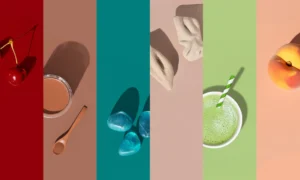Q: How would you describe your approach to photography?
Hannah Caldwell: For me, photography is about observing, interpreting, and translating the world as I experience it. It’s more than just capturing an image—it’s about revealing emotion, texture, and depth in the everyday. I see photography as a way to slow time, to uncover the layers of meaning in things we often take for granted. Whether it’s food, nature, or the structure and form of organic elements, I want my work to immerse the senses and evoke a feeling in the viewer.
Q: What draws you to food as a subject in your photography?
Hannah Caldwell: Food is deeply personal. It’s more than sustenance—it’s connection, culture, and tradition. Growing up, food was always at the heart of my family life—shared meals, holidays, the warmth of my mum’s homemade chicken soup. There’s something magical about how food can transcend time, distance, and cultural differences—a single taste can instantly transport us back to a moment in the past.
I think that’s why I’m drawn to photographing food. It tells a story—not just of the dish itself, but of its origins, the people who prepare it, the traditions behind it. Whether I’m capturing the rich textures of chocolate, the intricate folds of mushrooms, or the vibrant colors of fresh produce, my aim is always the same: to bring food to life in a way that stirs emotion and nostalgia.
Q: Your work explores light and darkness in a very intentional way. What inspires that contrast in your photography?
Hannah Caldwell: I’ve always been facinated with color and light. As a child, I loved arranging colored pencils in a rainbow, mesmerized by the infinite shades and possibilities. That love of color has never left me.
Light and shadow fascinate me because they create mood and meaning. Originally from Scotland, I fell in love with the Australian light while traveling. The strong contrast of bright sunlight and deep shadows, the vibrancy of the landscape, and the interplay of natural elements—it all influences how I shoot.
I often talk about “seeking light through darkness”—not just in photography but as a philosophy. The interplay of light and shadow adds depth, emotion, and storytelling to an image. Darkness isn’t just negative space—it’s a way to highlight the details, textures, and movement that might otherwise be overlooked.
Q: Your “Fungi Project” received international recognition. What was the inspiration behind it?
Hannah Caldwell: That project actually started by accident! I was walking through my local market when I came across the most incredible, sculptural oyster mushrooms. They were clustered in a way I had never seen before—so delicate yet structured, almost like works of art. I couldn’t stop staring at them.
I spent ages picking out the most interesting ones, and as I photographed them, I became obsessed with the intricate details—the delicate gills, the textures, the way light passed through them. That project became one of my most introspective and artistic pieces, exploring the hidden beauty in simple, organic forms. It reminded me that there is extraordinary beauty in things we often overlook.
Q: Beyond food, nature seems to play a big role in your photography. Why is that?
Hannah Caldwell: I feel at peace in nature. I think that’s why I’m drawn to capturing it—whether it’s food, flowers, or natural structures, there’s something deeply grounding about it. My mother was an artist, and I grew up surrounded by her paintings of floral arrangements and botanical subjects. That early exposure to art shaped the way I see the world.
I’m especially drawn to the lines in nature that echo the human form—the way tree branches resemble veins, how the folds of a mushroom mirror flowing fabric, or how water ripples like skin. There’s a sense of interconnectedness in nature that fascinates me, and I try to translate that into my work.
Q: You talk a lot about emotion in your work. How do you translate feeling into an image?
Hannah Caldwell: Photography is my way of expressing emotion and connecting with people. Every image I create is driven by a feeling—whether it’s nostalgia, warmth, longing, or stillness. Sometimes it’s about capturing the passage of time—aging, growth, change. Other times, it’s about storytelling—inviting the viewer to step into a moment of sensory immersion.
The way I use light, composition, and texture all play a role in that translation. I might use deep shadows to create intimacy and mood, or soft, natural light to evoke warmth and familiarity. My goal is for someone to not just see my work but feel it—to trigger a memory, spark curiosity, or make them pause and appreciate the beauty in something simple.
Q: What do you hope people take away from your photography?
Hannah Caldwell: I want people to see the beauty in the details—the textures, the layers, the depth of everyday things. Food, nature, even the passage of time—they all carry stories, and I hope my work inspires people to slow down and observe the world more closely.
More than anything, I want my images to evoke a feeling. Whether it’s through a plate of food that reminds someone of home, or a flower that brings back a childhood memory, photography is my way of capturing those connections and emotions.
At the end of the day, I’m always searching for light in the darkness—both literally and metaphorically. My work is about revealing beauty in the unexpected, finding meaning in the fleeting, and inviting people to experience the world through my eyes.
To view Hannah Caldwell’s food photography folio visit her website.




































